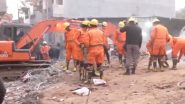Kansas City (US), Jun 1 (AP) The coronavirus pandemic that brought sports to a standstill for months has everyone wondering what games will be like when spectators are finally allowed back in. It will almost surely be different in ways big and small.
Fans could have their every move scrutinized by cameras and lasers. There might be nobody in the next seat to high-five after a touchdown.
Also Read | La Liga to Resume With Real Madrid Playing at Training Center Against Eibar on June 14.
The idea of passing cash to a beer vendor between innings will be a memory. Temperature screenings and medical checks could be mandatory. Virtual tickets will be the norm.
It all begs the question: Will fans even be able to enjoy the experience again?
“There's a wealth of unanticipated casualties, I guess, that are going to be part of this, things we all took for granted as part of the live game-day experience,” explained Nate Appleman, director of the sports, recreation and entertainment practice for Kansas City-based architectural firm HOK.
“Some things we have yet to fathom but will become painfully clear once we are allowed back into venues and get back to truly human nature, which is to gather and celebrate community.”
Some leagues are returning with few or no fans, including soccer in Germany, stock car racing in the U.S. and baseball in Japan. But as sports ramp up, The Associated Press found during interviews with more than two dozen experts in stadium design and infrastructure that the only thing that might look the same is what happens on the field of play.
The biggest short-term change will be social distancing, which already has permeated everyday life. Ticket sales will be capped. Entire rows and sections blocked off.
Seats on the aisle left open to keep a buffer from fans walking up the stairs. Fans will be given an entrance time to prevent crowding at the gates. Lines at restrooms and concessions will be limited. Congregating in the corridors will no longer be allowed.
“There's the old saying, 'Necessity is the mother of invention.' I would say we're in a heightened situation of necessity right now,” Appleman said.
“There are a lot of really smart people coming up with really cool initiatives that could just be a new way of doing things, and new isn't always bad. Sometimes change is good. Sometimes we have to adapt.”
Those plans bring both hope and fear: hope that some fans will be able to see their favorite teams in action, and fear that places that rely heavily on ticket sales will be able to make ends meet.
Mercedes-Benz Stadium, the home of the Falcons and Atlanta United, already has cashless systems in place for merchandise and concessions. Several professional teams are in talks with motion analytics company iinside, whose SafeDistance system uses lasers to map spaces and measure crowd density. At KeyBank Center in Buffalo, New York, a company called WaitTime utilizes an app to tell Sabres fans how long lines are at restrooms and concessions.
It all sounds a bit Orwellian — like Big Brother is watching you. The systems dance a fine line between informative and intrusive. But they also could mitigate the threat of spreading a virus, and that could make it all worthwhile.
“We're extrapolating off these trends that have already existed, and I think we're going to kick-start into 2025 even though it's only 2020,” said Jason Jennings, director of strategy and digital integration for the sports and entertainment group at Mortenson, which is wrapping up construction on the Raiders' new $2.4 billion stadium in Las Vegas.
“The technology is going to be deployed much faster because of the value it has for the fan experience and public health.”
Even the way facilities are cleaned will change. No longer will hosing down seats and sweeping up trash left by fans be enough. Venue giant ASM Global recently announced a new hygiene protocol for its 325 facilities worldwide, noting the importance of hewing to international health recommendations from the likes of WHO and the CDC.
Few professional teams have been willing to divulge their full reopening strategies, whether that be potential seating layouts or infrastructure upgrades designed to keep fans safe. That's because the rapidly changing social and political environment coupled with the unpredictable nature of the virus have made planning difficult.
“In large masses, there is no system that can effectively prevent another person from giving germs to a second individual,” said Philip Tierno, a clinical professor of pathology at New York University's Grossman School of Medicine.
"If they sneeze or cough or talk directly, or even breathe directly on a person, there is no system that can prevent that." (AP)
(This is an unedited and auto-generated story from Syndicated News feed, LatestLY Staff may not have modified or edited the content body)













 Quickly
Quickly





















